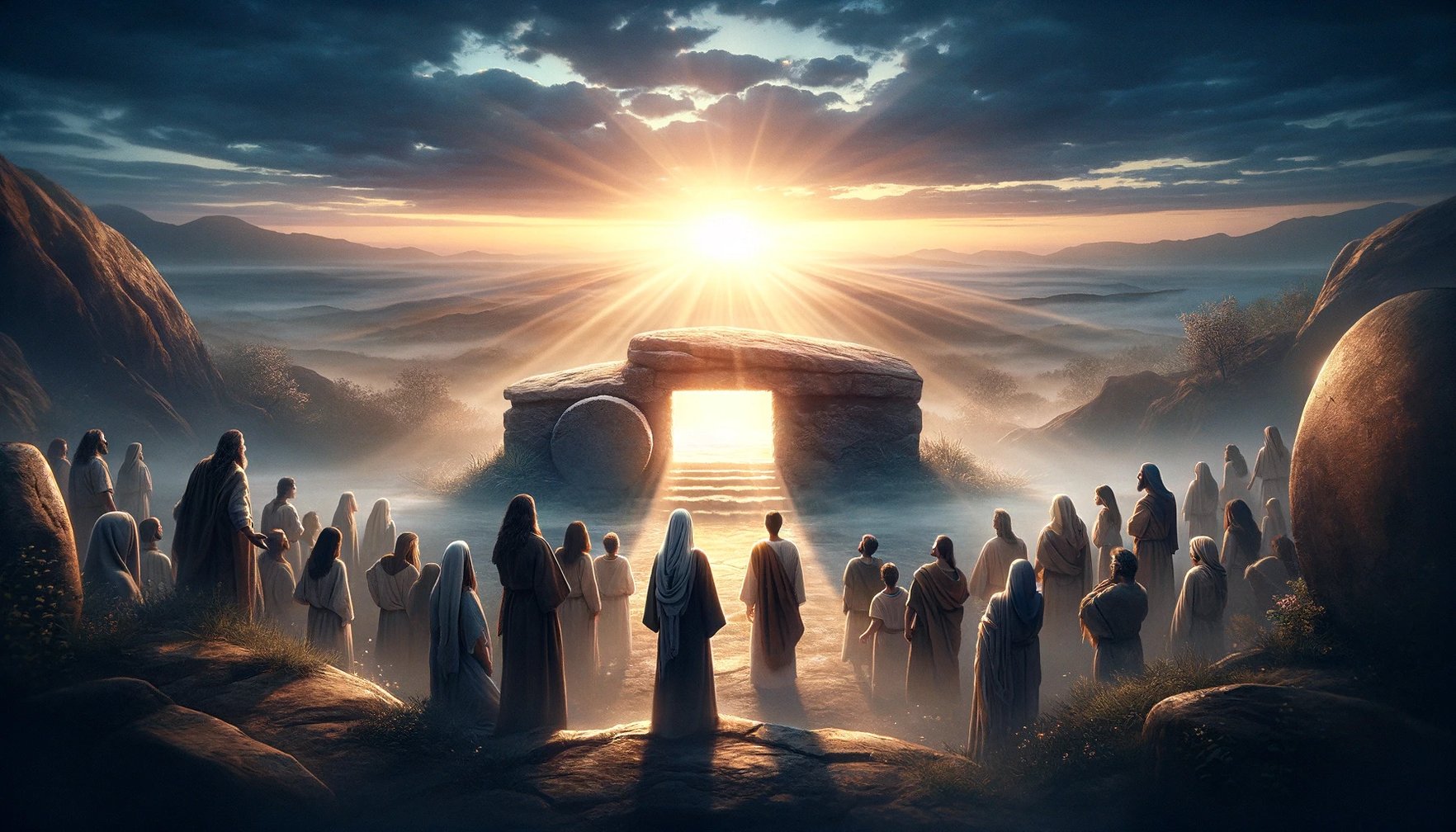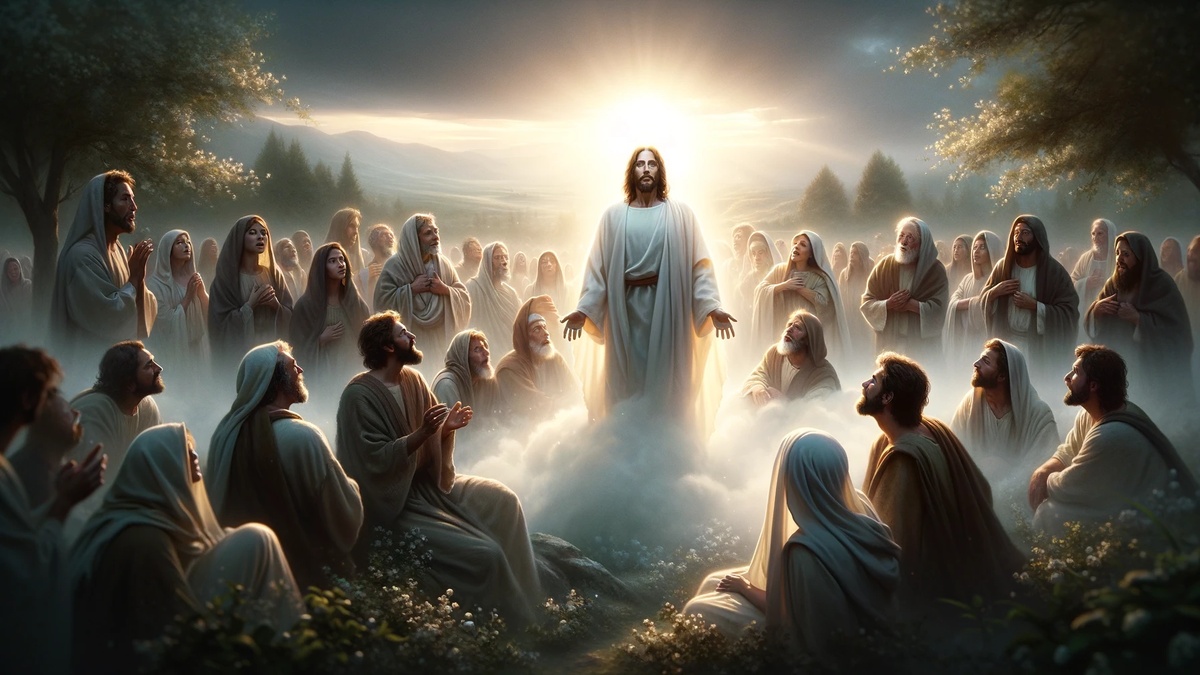Home>Christian Videos>Bible Stories>Where In The Bible Does It Talk About The Resurrection Of Jesus Christ


Bible Stories
Where In The Bible Does It Talk About The Resurrection Of Jesus Christ
Published: March 2, 2024
Jason DeRose, Managing Editor at Christian.net, uses his expertise in religion and journalism to deepen understanding of faith's societal impacts. His editorial leadership, coupled with a strong academic background, enriches the platform’s diverse content, earning him recognition in both journalism and religious circles.
Discover the biblical account of the resurrection of Jesus Christ and its significance in the collection of Bible stories. Explore the powerful narrative and its impact on Christian faith.
(Many of the links in this article redirect to a specific reviewed product. Your purchase of these products through affiliate links helps to generate commission for Christian.net, at no extra cost. Learn more)
Table of Contents
Introduction
The resurrection of Jesus Christ is a central and foundational belief in Christianity. It is the belief that Jesus, after being crucified and buried, rose from the dead on the third day. This event is celebrated as Easter by Christians around the world. The resurrection is a key doctrine that sets Christianity apart from other religions and is a source of hope and joy for believers. But where in the Bible does it talk about the resurrection of Jesus Christ? In this article, we will explore the biblical references to the resurrection, examining the accounts in the Gospels, the letters of Paul, the Book of Acts, and the Book of Revelation. Let's delve into the biblical passages that testify to the resurrection of Jesus Christ and its significance in the Christian faith.
Read more: Where Does It Talk About Advent In The Bible
The Gospels and the Resurrection
The Gospels, which include the books of Matthew, Mark, Luke, and John, are the first four books of the New Testament and provide detailed accounts of the life, teachings, death, and resurrection of Jesus Christ. The resurrection of Jesus is a central theme in each of the Gospels, and each account offers unique perspectives and details about this pivotal event in Christian belief.
1. The Gospel of Matthew
In the Gospel of Matthew, the resurrection of Jesus is described in detail. It recounts the discovery of the empty tomb by Mary Magdalene and the other Mary, the appearance of an angel who announces Jesus' resurrection, and the subsequent encounter with Jesus himself. This Gospel emphasizes the fulfillment of Old Testament prophecies regarding the Messiah's resurrection and the Great Commission, in which Jesus instructs his disciples to spread the news of his resurrection to all nations.
2. The Gospel of Mark
The Gospel of Mark also provides an account of the resurrection of Jesus. It narrates the visit of the women to the tomb, where they encounter a young man who informs them of Jesus' resurrection. Mark's Gospel highlights the initial disbelief of the disciples and the subsequent appearances of Jesus to them, emphasizing the importance of faith and belief in the resurrection.
3. The Gospel of Luke
In the Gospel of Luke, the resurrection of Jesus is presented as the culmination of the fulfillment of God's plan of salvation. It includes the account of the empty tomb, the appearance of angels to the women, the encounter with Jesus on the road to Emmaus, and his appearance to the disciples. Luke's Gospel underscores the continuity between Jesus' earthly ministry and his resurrection, emphasizing the significance of his redemptive work.
4. The Gospel of John
The Gospel of John provides a unique perspective on the resurrection of Jesus, focusing on the personal encounters with the risen Christ. It includes the account of Mary Magdalene's encounter with Jesus at the tomb, the appearance of Jesus to the disciples, and the restoration of Peter. John's Gospel emphasizes the transformative power of encountering the resurrected Jesus and the commissioning of the disciples for their mission.
The Gospels collectively present a comprehensive and cohesive testimony to the resurrection of Jesus Christ, affirming its central importance in the Christian faith and its enduring significance for believers throughout history.
The Letters of Paul and the Resurrection
The letters of Paul, also known as the Pauline epistles, are a collection of writings by the apostle Paul, who played a significant role in the early spread of Christianity. In his letters, Paul expounds on various theological doctrines, including the resurrection of Jesus Christ. His writings provide profound insights into the significance and implications of the resurrection for Christian belief and practice.
-
Romans
In the letter to the Romans, Paul articulates the transformative power of Christ's resurrection. He emphasizes that through Jesus' resurrection, believers are united with him in his death and raised to newness of life. Paul underscores the victory over sin and death that the resurrection brings, highlighting its liberating and life-transforming impact on those who are in Christ. -
1 Corinthians
Paul's first letter to the Corinthians addresses the resurrection in depth, particularly in 1 Corinthians 15. He presents a robust defense of the resurrection, affirming its non-negotiable importance to the Christian faith. Paul elucidates the implications of denying the resurrection and expounds on the nature of the resurrected body, emphasizing the continuity between the natural body and the spiritual body. -
Philippians
In the letter to the Philippians, Paul expresses his longing to know Christ and the power of his resurrection. He underscores the surpassing value of knowing Christ and the transformative impact of sharing in his resurrection. Paul's emphasis on the resurrection as a source of spiritual power and communion with Christ underscores its central place in the Christian experience. -
Colossians
Paul's letter to the Colossians highlights the resurrection as a foundational truth of the Christian faith. He emphasizes that believers are raised with Christ and exhorts them to set their minds on the things above, where Christ is seated at the right hand of God. The resurrection serves as the basis for the believer's new identity and the hope of future glory. -
1 Thessalonians
In his first letter to the Thessalonians, Paul offers assurance and comfort regarding the resurrection. He encourages believers concerning those who have died, assuring them that the dead in Christ will rise first when the Lord returns. Paul's teachings on the resurrection provide hope and consolation to the Thessalonian believers, affirming the ultimate victory over death through Christ.
Paul's letters provide profound theological reflections on the resurrection of Jesus Christ, elucidating its transformative power, its implications for believers, and its foundational significance for the Christian faith. His writings continue to inspire and edify believers, pointing to the enduring hope and assurance found in the resurrection of Jesus.
The Book of Acts and the Resurrection
The Book of Acts, written by Luke, serves as a historical account of the early church and the spread of Christianity after the resurrection of Jesus Christ. It provides valuable insights into the apostles' teachings and the impact of the resurrection on their ministry and the growth of the Christian community.
-
Pentecost and the Outpouring of the Holy Spirit
The Book of Acts begins with the account of the day of Pentecost, where the Holy Spirit descends upon the disciples, empowering them to proclaim the message of Jesus' resurrection to people of various languages. This event marks the inauguration of the church's mission and the outpouring of divine power, directly linked to the reality of Jesus' resurrection and exaltation. -
Preaching of the Resurrection
Throughout the Book of Acts, the apostles consistently emphasize the resurrection of Jesus Christ in their preaching. They boldly proclaim the reality of the resurrection as the central message of the gospel, emphasizing its fulfillment of Old Testament prophecies and its significance for salvation and forgiveness of sins. -
Miracles and Signs
The apostles' ministry in the Book of Acts is characterized by miraculous signs and wonders that testify to the reality of Jesus' resurrection. They heal the sick, raise the dead, and perform extraordinary feats in the name of Jesus, demonstrating the power and authority that stem from his resurrection and exaltation. -
Martyrdom and Perseverance
The apostles and early believers in the Book of Acts face persecution and martyrdom due to their unwavering commitment to the message of Jesus' resurrection. Their willingness to endure suffering and death testifies to their firm conviction in the reality of the resurrection and its transformative impact on their lives. -
Expansion of the Church
The Book of Acts chronicles the rapid expansion of the Christian community, fueled by the apostles' testimony to the resurrection of Jesus Christ. The message of the resurrection spreads across geographical and cultural boundaries, leading to the establishment of vibrant Christian communities and the transformation of countless lives.
The Book of Acts serves as a compelling narrative of the profound impact of the resurrection of Jesus Christ on the early church and the subsequent spread of Christianity. It underscores the central role of the resurrection in shaping the beliefs, mission, and experiences of the apostles and early believers, highlighting its enduring significance for the Christian faith.
The Book of Revelation and the Resurrection
The Book of Revelation, attributed to the apostle John, is a prophetic and apocalyptic work that offers a vivid portrayal of the culmination of God's redemptive plan and the ultimate victory of Christ. While the book is primarily known for its eschatological themes, it also contains significant references to the resurrection of Jesus Christ and its implications for believers.
-
The Risen Christ
The opening chapter of Revelation presents a vision of the glorified and risen Christ, who appears to John in a vision. The description of Christ's appearance, his proclamation of being the First and the Last, and his possession of the keys of death and Hades underscore his triumph over death and his authority as the resurrected Lord. -
The Lamb Who Was Slain
Throughout Revelation, the imagery of the Lamb who was slain and yet lives is recurrent. This powerful symbol represents Jesus Christ, whose sacrificial death and subsequent resurrection are central to the redemptive narrative. The Lamb's victorious position on the throne and his role in the unfolding of God's purposes highlight the significance of his resurrection in the cosmic order. -
The Firstfruits of the Resurrection
In Revelation 1:5, Jesus is described as the faithful witness, the firstborn from the dead, and the ruler of the kings of the earth. This title emphasizes his preeminence as the one who has conquered death and holds authority over all creation. The language of firstborn from the dead points to the resurrection as a foundational aspect of Christ's identity and sovereignty. -
The Hope of Resurrection
The promise of resurrection and eternal life is a recurring theme in Revelation, offering hope and assurance to believers. The vision of the new heaven and the new earth, the defeat of death and Hades, and the invitation to partake in the water of life freely all point to the ultimate triumph of life over death, made possible through the resurrection of Jesus Christ. -
The Resurrection and Final Judgment
Revelation depicts the future resurrection of the dead and the final judgment before the great white throne. The resurrection of both the righteous and the wicked is portrayed, underscoring the universal and transformative impact of Christ's victory over death. This eschatological vision reaffirms the centrality of the resurrection in determining the ultimate destiny of humanity.
The Book of Revelation provides a rich tapestry of imagery and symbolism that underscores the profound significance of the resurrection of Jesus Christ. It portrays the risen Christ as the exalted Lord, the victorious Lamb, and the source of hope for believers, while also pointing to the ultimate fulfillment of God's redemptive purposes through the resurrection.
Conclusion
The resurrection of Jesus Christ is a foundational and central belief in Christianity, and its significance reverberates throughout the biblical narrative. The Gospels provide detailed accounts of the empty tomb, the appearances of Jesus to his disciples, and the commissioning of the early believers to proclaim the good news of his resurrection. The letters of Paul offer profound theological reflections on the transformative power of the resurrection, its implications for believers, and its foundational significance for the Christian faith. The Book of Acts chronicles the impact of the resurrection on the early church, highlighting its role in the outpouring of the Holy Spirit, the preaching of the apostles, and the expansion of the Christian community. The Book of Revelation presents a visionary portrayal of the risen Christ, the hope of resurrection, and the ultimate triumph of life over death. Collectively, these biblical accounts testify to the enduring significance of the resurrection of Jesus Christ as the cornerstone of Christian faith, offering hope, assurance, and transformation to believers throughout history.













